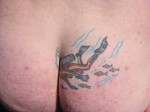30/07/2009
sharks and symbolism
“There isn't any symbolism. The sea is the sea. The old man is an old man. The boy is a boy and the fish is a fish. The shark are all sharks no better and no worse. All the symbolism that people say is shit. What goes beyond is what you see beyond when you know.”
Ernest Hemingway
12:36 Publié dans Sharkisms | Lien permanent | Commentaires (0) | Tags : requin, shark, hemingway, animaux, citation, quote
29/07/2008
In which circumstances did sharks attack the sailors of the USS Indianapolis ?
‘When night came, things would bump against you in the dark or brush against your leg and you would wonder what it was. But honestly, in the entire 110 hours I was in the water I did not see a man attacked by a shark. However, the destroyers that picked up the bodies afterwards found a large number of those bodies. In the report, I read 56 bodies were mutilated, Maybe the sharks were satisfied with the dead. They didn't have to bite the living. »
Lewis L. Haynes, survivor
There is a mythical story (amonsgt others) when it comes to shark, it is the story of the wreck of the US cruiser Indianapolis. Mythical is the word since it has been the subejct of many narratives, the most famous one being probably the one made by Quint, the old shark hunter of Jaws, a modern version of Achab. According to him, sharks would have harassed relentlessly the sailors of the Indianapolis for several days, killing one, biting the leg off another one in a sort of infamous frenesy that only the late arrival of the rescue team managed to stop. According to Quint all the deaths following the wreck can be blamed on sharks.
This story becomes even more mythical when one knows that the USS Indianapolis was on the way back from delivering the devatasting bomb which was to be dropped several days later on Hiroshima. Nature was seemingly taking its revenge by making a handfull of men pay for the destructive act of « hybris » made by a country.
The accounts given by the survivors, though sometimes conflicting, seem to tell us a story altogether quite different from the one told by Quint.
First and on the contrary to what one might think, the first shark attack only took place long after the boat had sunk. At least 14 hours, probably more.
The wreck took place round midnight on the Sunday and the first attack according to one witness may have taken place late during the following day. According to other survivors, the first attacks only took place the night following the wreck. Others even say that serious attacks only began on the Tuesday. One should note that most of the time it was not possible for witness to clearly distinguish if the sharks were attacking someone alive or dead.
Sharks, by far, were not the only cause of worry among the survivors. The sun, the lack of water and hypothermia were also taking their toll, despite the temperature of the water. Most probably some of what was perceived as attacks was in fact sharks attacking dead bodies flotaing on the surface.
Another reason which may explain the apparent contradiction between between the narratives of the survivors, is the fact that those survivors were spread in groups isolated from one another. 900 men who stay in the water for sevceral days don’t stay perfectly grouped . What certain groups went through may not be similar to others.
The survivors had the good idea to try and stay together as much as they could, forming groups. This must have intimidated sharks at first. When the first attacks occured they involved men swimming at the periphery of the groups.
But since a good idea is often followed by a bad one (for the world to remain symetrical), the seamen couldn’t avoid splashing the wtaer in presence of sharks, thus following the instructions given by the US navy. Mistake. This probably attracted more sharks.
With those unwelcomed splashing came the vomit of the sailors. A cruiser of such a size which sinks with its tanks fulll releases a huge quantity of oil. The poor men who were struggling in this treacle and were breathing it paid the price for it. Expelled food, for fish is opportunity food. Small fish attract bigger ones and sharks soon follow.
Apparently, the attacks during the first three days were not regular. According to the time of day and more so night, they would amplify. They would amplify at the fall of the night and would slow down and even stop during the day. At least untill the third day. This behaviour seems to match the one of the two species which were clearly identified : the tiger shark and the oceanic whitetip. Regarding this matter, it is most probable that at least one other specie was also present, be it silkies or silvertips which are often found in the company of oceanic whitetips.
The idea of this article is not minimize the nightmare that the crew of the indianapolis went through, but to show it under another light- maybe worse- than the one we are used to. Three conclusions come to mind when reading the accounts of the survivors.
The first one is that sharks didn’t rush agressively and with no reason to attack the men in the water. They were stimulated by scents, by a a probably large presence of other fish, by vibrations and by floating bodies. Nonetheless, it took fourteen hours for the first attacks to take place. And even then, attacks were erratic. Sharks (even when they are represented by to of the supposedly most dangeroius species) are cautious predators far less dangerous than their land cousins.
The second conclusion is that maybe the importance of sharks is overestimated in the suffering of the men from the Indianapolis. Realistic accounts lead to thinking that out of the 600 men that died after the boat had sunk, sharks have been involved in the deaths of between 50 and 80. Many accounts of survivors confirm this by just vaguely mentioning the presence of sharks. Hallucinations which made some of them think they had seen the ship beneath them or a an island in the distance, painfull sunburns, thirst, cold, death by drowning when people made the mistake of falling asleep, were all sufferings at least as painfull and unbearable than sharks.
But the most horrible fear those sailors had to fight against, which is underlined by some survivors, was the fear of being abandoned. The fear of dying lost at sea. The fear that nobody will come and look for you. Some even point out that real courage is to choose to live, or at least try to, in those circumstances. Sharks were just one part, amongst many others, which composed this nightmare.
The third conclusion, which leads in the same way than the previous one, is that sharks were maybe the scapegoats (amongst others) which allowed to mask the fact that the US Navy had forgotten its men for four days.
Sometimes, I even wonder if they were not seamen of the Indianapolis who, despite surviving the wreckage and the sharks, were not rescued. who saw the planes and the boat coming and leaving, and whom sharks didn’t even bother attack. They may have died from cold and despair in a warm sea.
Those men may have experienced the worst.
15:30 Publié dans Articles in English | Lien permanent | Commentaires (0) | Tags : USS indianapolis, shark, attack, Oceanic whitetip, Tiger, second world war
12/01/2008
La femelle du requin

"De tous ces êtres humains, qui remuent les quatre membres dans ce continent peu ferme, les requins ne font bientôt qu’une omelette sans œufs, et se la partagent d’après la loi du plus fort. »
Isidore Ducasse, Comte de Lautréamont
02:40 Publié dans Sharkisms | Lien permanent | Commentaires (1) | Tags : dali, requin, shark, lautréamont, sharkuterie, animaux
15/03/2007
Big bald sun
"The sun's coming up, like a big bald head... It's sharky's day today... All of life comes from some strange lagoon. It rises up, it bucks up to its full height from a boggy swamp on a foggy night."
Laurie Anderson
02:15 Publié dans Sharkisms | Lien permanent | Commentaires (0) | Tags : Laurie Anderson, shark, requin, bald






